IDEX Online Research: Jewelry Inflation Flares At Wholesale, But Retail Prices Stable in December (Full Report)
January 24, 10
Inflation at both the jewelry wholesale and retail level may seem tame for 2009, but the underlying components of inflation were anything but stable. Commodities and currencies showed wild gyrations on a month-to-month basis during the year. When the dust settled, it was the same old story: margins were squeezed at almost every level of the jewelry pipeline. Consumers were the winners, and everyone else suffered.
· Precious Metal Costs: A Roller-Coaster – Investors were conflicted: should they invest in “hard assets” such as precious metals, or should they seek bargains in a depressed stock market? There was no clear answer, and as a result, stock indices and precious metals costs showed wild swings.
· Currencies Unstable – The U.S. dollar, traditionally the bedrock of global currencies, lost significant value in 2009 as investors fled the currency in favor of the Euro. However, with the
· Demand & Supply Unstable – Normally, prices of goods correlate reasonably closely with demand and supply. Demand for jewelry weakened substantially at the end of 2008 and early 2009, so prices reflected an over-supply of goods and poor demand. However, as the year closed, jewelry demand was clearly recovering, and prices began to creep up.
The table below summarizes the major components of jewelry inflation for both December 2009 as well as the full calendar year.
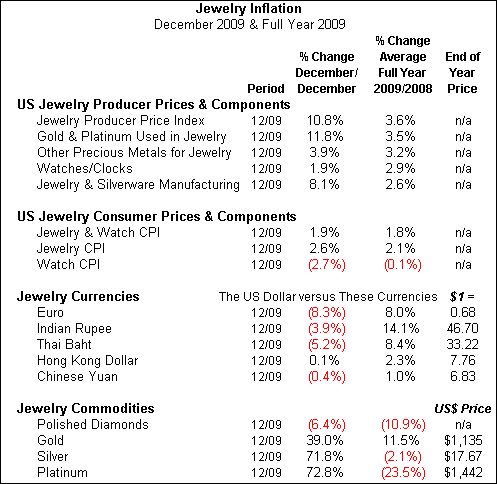
Source: Various Markets
December Jewelry Inflation Surges At Wholesale Level
During December 2009, jewelry price inflation was up a dramatic 10.8 percent at the producer level on a year-to-year basis, as measured by the Jewelry Producer Price Index (JPPI). As the table above illustrates, dramatic increases in the price of jewelry’s precious metals – gold, silver and platinum – fueled higher jewelry wholesale prices. Currencies were relatively stable on a year-to-year basis for December, so jewelry manufacturing labor costs were also likely stable.
The following graph illustrates the monthly inflation rate at the jewelry producer level for the past two years. It is clear that inflation is surging at the producer level in the past four months, after remaining relatively calm earlier in 2009.
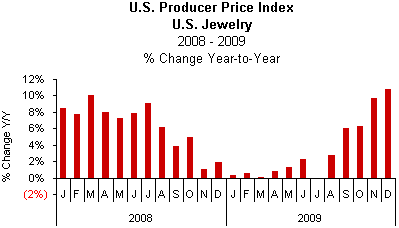
Source: BLS
On an underlying basis, precious metal jewelry – primarily gold merchandise – showed slightly more inflation at the producer level than all jewelry. Total jewelry price inflation at the wholesale level was up 10.8 percent in December; price inflation for gold and platinum jewelry rose by 11.8 percent.
The graph below compares price inflation trends for all jewelry versus precious metal jewelry by month in 2008 and 2009. After being relatively tame earlier in the year, wholesale prices of precious metals jewelry began to rise sharply in the fourth quarter, peaking in December.
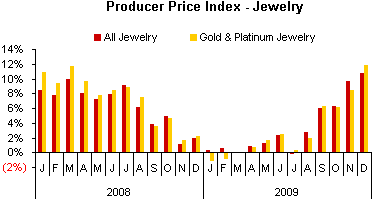 Source: BLS |
Watch Price Inflation Moderate at Producer Level in December
One thing is for sure: fine watch prices did not contribute to the sharp rise in jewelry producer price inflation during December. Fine watch prices were up a very modest 1.9 percent at the producer level during the month. Unfortunately, demand for watches has remained weak; thus, watch producers have little or no pricing power.
The graph below illustrates month-by-month price inflation trends for fine watches at the producer level during 2008 and 2009.
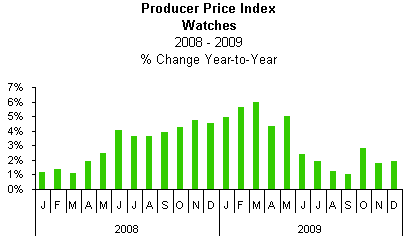
Source: BLS
Producer Price Inflation Modest For Full Year 2009
Despite significant monthly price volatility, the annual inflation rate for jewelry at the producer (wholesale) level remained modest during 2009.
· Jewelry Producer Price Index (JPPI) Year 2009 = +3.6 percent
· Watch Producer Price Index (WPPI) Year 2009 = +2.9 percent
Over the past twenty years, the Jewelry Producer Price Inflation rate has been +1.6 percent. Thus, the Jewelry Producer Price Inflation index in 2009 of +3.6 percent significantly exceeded the average of the past two decades. However, when compared to the past few years, it was a very moderate level of inflation, as the graph below illustrates.
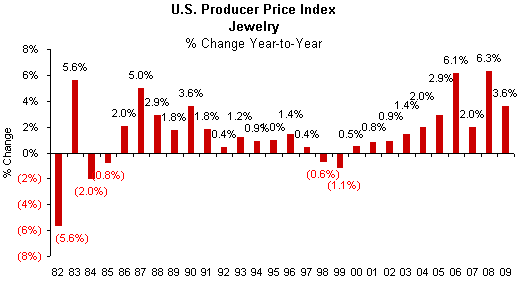 Source: BLS |
Jewelry Retail Price Inflation Modest in December
During December 2009, retail prices for jewelry and watches rose by a very modest 1.9 percent, about in line with the average for the year.
The graph below illustrates monthly retail jewelry price inflation for the past two years.
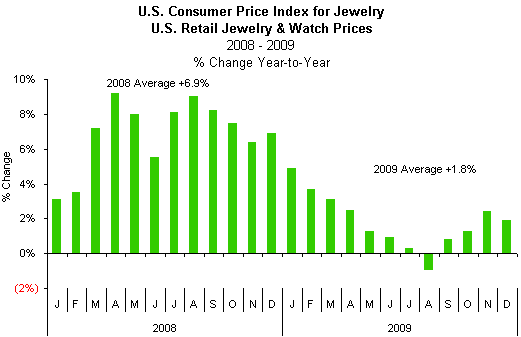
Source: BLS
Underlying Components of JCPI Show Moderate Swings in December
Jewelry prices were up 2.6 percent, while watch prices at retail fell by 2.7 percent during the month, when compared to the same month in 2008. The decline in fine watch prices is no surprise, since watch prices at the producer level showed little movement. Watches have shown price deflation at the retail level for virtually every month during the second half of 2009. In contrast, retail prices of jewelry have moved higher in the final half of 2009, driven largely by higher precious metals prices.
The graph below compares the overall inflation rate for jewelry and watches by month to each of the component inflation rates – jewelry and watches separately.
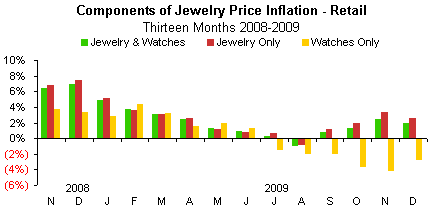
Source: BLS
Annual Retail Jewelry Price Inflation Modest in 2009
In contrast to the prior three years, retail price inflation for jewelry in 2009 showed only a very modest increase of +1.8 percent. Clearly, the recessionary environment had a negative impact on jewelry prices. Retail jewelers were unable to raise prices for fear of turning off already-weak demand for jewelry. Thus, the only winners in the inflation game were the consumers who were able to buy jewelry at prices that probably won’t repeat themselves in the next decade.
At the component level, jewelry prices rose by 2.1 percent in 2009 while fine watch prices declined by a very modest 0.1 percent - essentially, fine watch prices were about flat for the year, when compared to the average price in 2008.
The graph below summarizes the annual rate of retail jewelry price inflation in the U.S. market for the past two decades.
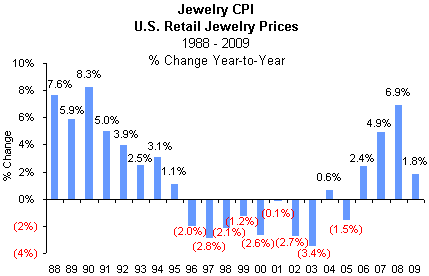 Source: BLS |
Jewelry Producer Inflation Rates Outstrip Retail Jewelry Inflation Rates During Second Half of 2009
The margin squeeze is real: jewelry producer prices have risen dramatically faster than retail jewelry prices during the final half of 2009.
The graph below compares retail jewelry prices and wholesale jewelry prices on a monthly basis during 2009.
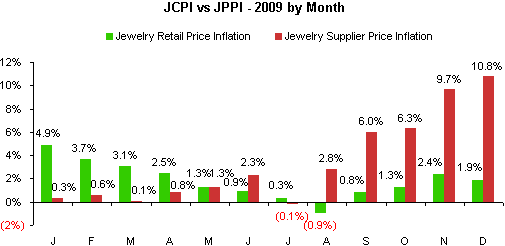
Source: BLS
Annual Jewelry Prices At Wholesale Rise More Than Retail Jewelry Prices for Most of the Decade of the 2000s
Unfortunately, the monthly inflation trends for the jewelry industry during 2009 were reflected in annual trends, not only for 2009 but also for several prior years.
The graph below illustrates the comparison in wholesale jewelry prices versus retail jewelry prices for the past two decades.
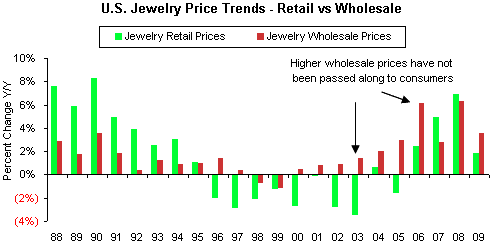
Source: Dept of Commerce
Outlook: Retail Jewelry Prices Are Headed Higher; Watch Price Inflation Much Less Likely
With the stock market up, but uncertain, and with the housing market scraping along the bottom, investors and consumers are looking at hard assets that may hold their value. They have clearly turned their attention to precious metals, and their buying has pushed prices up sharply over the past year. We are already seeing retail prices move up as precious metals prices rise.
The only good news is that the retail prices of lower price-point merchandise probably won’t rise as quickly has more expensive goods. The largest cost component of lower price-point merchandise – under $300 at retail – is labor. Globally, currencies have been stable, and there is some indication that the U.S. dollar may be strengthening.
However, jewelry merchandise priced at $1,000 and above retail is likely to rise more sharply in price since the costs of both the precious metals and precious gemstones are the largest cost component of the goods.
It is difficult to forecast watch prices. Luxury buyers have been on holiday for the past two years, but appear to be returning to the market. However, more consumers have forsaken their watches in favor of checking the time with their mobile phones, computers, and other electronic gadgets.